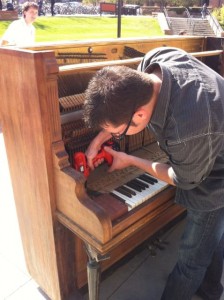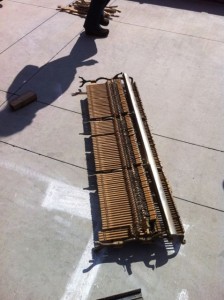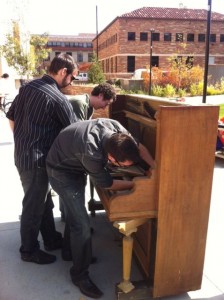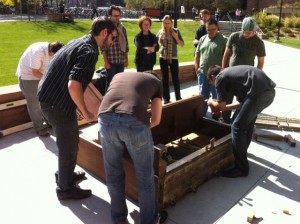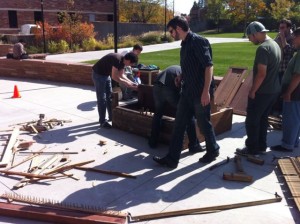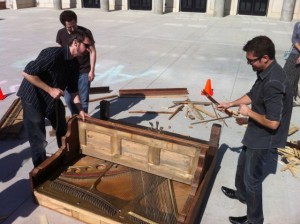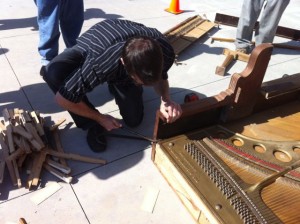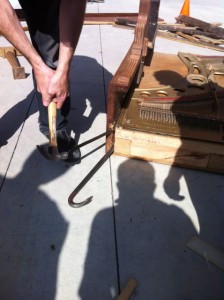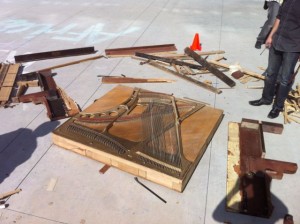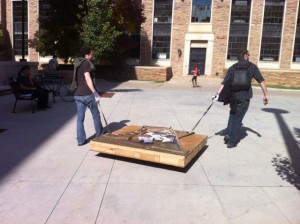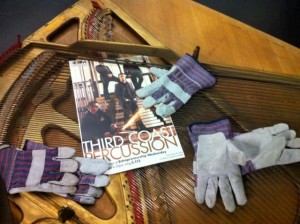Travel Log: How to Build a Pianotron

Published November 1, 2012 by Third Coast Percussion | Share this post!
TCP was in Colorado this past month for a week and a half of performances and masterclasses throughout the state. The Rocky Mountain State (aka the land of Green Chili and Subaru’s) provided us with many amazing experiences, topped off in Boulder, CO where we were given a very old and wheezy upright piano to nip/tuck into Pianotron v2.0. The first Pianotron was the brainchild of Clay Condon, and made its debut back in 2009 on a performance of Louis Andriessen’s Workers Union as part of TCP’s Chicago Concert Season. Since then, we’ve made it part of our John Cage repertoire in the third movement his early work Quartet.
TCP was in Colorado this past month for a week and a half of performances and masterclasses throughout the state. The Rocky Mountain State (aka the land of Green Chili and Subaru’s) provided us with many amazing experiences, topped off in Boulder, CO where we were given a very old and wheezy upright piano to nip/tuck into Pianotron v2.0. The first Pianotron was the brainchild of Clay Condon, and made its debut back in 2009 on a performance of Louis Andriessen’s Workers Union as part of TCP’s Chicago Concert Season. Since then, we’ve made it part of our John Cage repertoire in the third movement his early work Quartet.
Step 1: Sedate and prep patient for surgery. We dig our piano out from a dusty basement corner and move to the CU Boulder student commons. We check our surgical tools.
Step 2: Begin with incisions to the sternum, exposing arteries. Remove Arteries.
Step 3: Ask Clay and Rob to help (Dave has a phobia of blood. He aced the MCAT’s but just couldn’t cut it in the OR…. he sucks it up to take some photos…..). There are a lot small bones in the way. Get rid of them, you don’t need them. We find 88 bones in all and give them away as souvenirs.
Step 4: New plan: lay the patient down and break out out the larger tools. Cue crowbars.
Step 5: Almost done, just have to trim a little more fat off the edge.
Step 6: Success! Move patient to recovery room before the debut performance.
There’s something about a piano – it’s that one instrument that we all have some personal affection towards. It’s the instrument you grew up with, it was part of your home. It sat in your living room, it was part of the family. You and your siblings learned to play on the same piano that your mother or father did. It was passed down from your grandparents to your parents to you. A piano brings out all of these memories in us and to destroy something so cherished brings out some interesting emotions in people. But, really, making a Pianotron isn’t destroying anything:). It’s bringing a new life to a broken instrument – reappropriating a thing of the past that’s no longer useful and bringing it back to it’s most important purpose: making music.
In writing this, I’m reminded of an article and video from the New York Times I read over a year ago about “where piano’s go to die”. Check it out: For More Pianos, Last Note is Thud in the Dump
More people should make Pianotron’s:).
We loved our new instrument. The shows were fantastic and we laughed as faculty and students at CU Boulder haggled over who got to keep the pianotron after it was all done. Many thanks to everyone at CU Boulder for their assistance. A special shout out to Hunter Ewen, the mastermind behind the event at the Atlas Theater. It’s so great to work with people with the mindset that anything and everything is possible:).
-PJM




